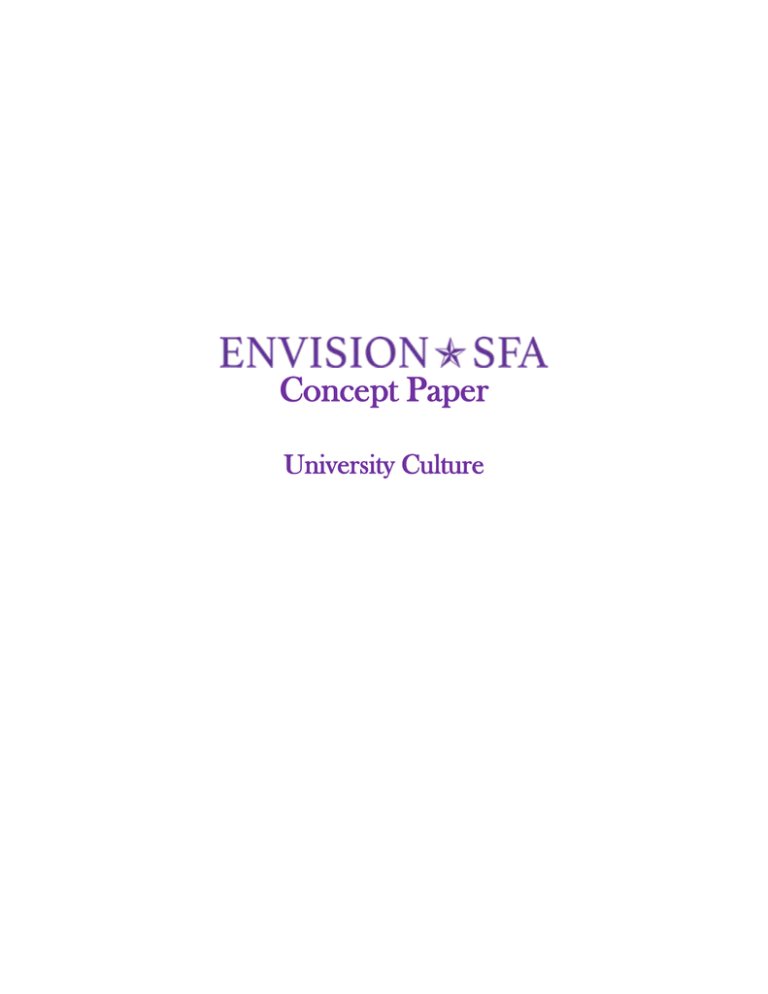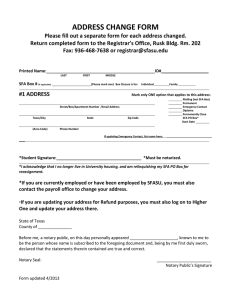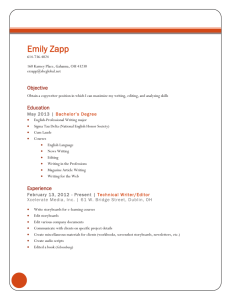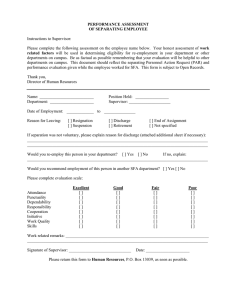Concept Paper University Culture
advertisement

Concept Paper University Culture University Culture Executive summary: University culture can be defined as an institution's norms and practices in conducting its business in a manner that has a powerful impact on the attitudes, behaviors, and socialization of its internal and external stakeholders. As much as these norms and practices set the tone for how the institution is perceived by its stakeholders, they are also molded and informed by the values, beliefs, and actions of the said stakeholders. A positive, productive university culture is fundamental to a dynamic, learning-centered university dedicated to enhancing student outcomes and success. One essential factor for the creation and maintenance of such a university culture is a supportive administration who works actively with faculty, staff, and students to seek consensus on the university’s direction and priorities. This collaborative approach produces engaged employees committed to the university’s mission, invested in objectives and priorities they helped to establish, and motivated to assist students in gleaning an enriching experience during their time on campus. SFA must develop and foster a culture of employee engagement to attain the university’s strategic goals and objectives. Figure 1: SPT Interview Data Word Cloud A word cloud is a visual representation of textual data and depicts the frequency that a specific word is used by interview and survey respondents. The larger the word, the more frequently it was used. The Strategic Planning Team conducted interviews and surveys of over 2000 SFA stakeholders representing 52 varied constituent groups during the fall 2014 strategic planning process. The word cloud in Figure 1 illustrates the predominant words expressed by SFA interview and survey participants. The majority of the most commonly used words are relevant to the university culture. Examining the campus climate and culture is an important part of a university assessment, especially as postsecondary institutions enter an era of evidence-based practice, and aim to achieve enhanced levels of accountability and organizational learning, driving to ever-higher levels of performance. Launching a well-designed engagement effort creates an environment that can lead to new initiatives and enhanced understanding of key issues that university leadership must address toward creating a successful campus environment and position the campus community toward a more sophisticated understanding of various issues affecting faculty, staff, and most importantly – students. Lessons Learned: Two recurring themes from the strategic planning team’s interviews and research that are pertinent to the conceptualization of university culture are the perceptions of disengagement, most commonly expressed as lack of effective communication between and among university stakeholders, and a compliance-orientated work environment. Concerns related to communication, collaboration, trust, and University Culture transparency have been documented in SFA strategic plan development efforts since 1987 (SFASU Strategic Plan Oversight Committee, 2005). The data gathered during the development of the SFA strategic plan points towards a sense of overreliance on bureaucratic procedures and compliance rubrics that stifle initiative and growth while creating a potentially confrontational environment between the leaders and the led that is void of meaningful dialogue or engagement. Employee engagement, which includes direction, integration, mediation, education, motivation, representation, and trust creation, is fundamental to building a positive work culture capable of achieving an organization’s strategic aims. (Salacuse, 2005) Despite well-intentioned efforts to move the University forward through various strategic planning efforts, many faculty, staff, and administrators are worried that input from the campus community will be overlooked as it was during previous strategic planning attempts. The 2005 Strategic Plan Oversight Committee noted in a report to the Board of Regents that “Particularly damning among the negative impressions, the committee found that many in the campus community do not believe everyone in decision-making positions is ‘on board’ with the strategic plan; significant decisions continue to be made without reference to the strategic plan” (SFASU Strategic Plan Oversight Committee, 2005). National Trends Compliance: Higher education has entered an era of rapidly increasing regulatory activity at both the federal and the state levels, resulting in increasingly bureaucratic cultures of compliance that force higher education to adapt to ever-growing demands for accountability from policy makers, regulators, and the public (American Council on Education, 2014). The focus on compliance without additional resources to perform them tends to alter the focus of SFA and other universities away from a culture of success, dedicated to creating transformational experiences for their students and towards seemingly endless initiatives and rubrics that pull faculty and staff away from their primary duties. Change: Regional universities depend traditionally on a local student base and state appropriations determined by total student enrollment. SFA continues to serve students in the Deep East Texas region, but the University has also increased its recruiting efforts in the metro areas of Texas, attracting more urban and suburban students to Nacogdoches. These students now account for two thirds of SFA’s undergraduate enrollment. While these changes have helped us to maintain healthy enrollment numbers, the arrival of a more diverse student population brings many pressures. Students expect outstanding facilities and technology, flexible options for degree completion like online and short-length courses, and distinctive degree programs. SFA is proud of its reputation for providing a “personalized” approach to undergraduate education. As a result, students who choose SFA expect enhanced services tailored to their needs, both in and out of the classroom, and real-life experience regardless of our small-town location. SFA seeks to provide such opportunities despite shrinking state dollars and industry-wide pressure to raise graduation rates, reduce time to degree and strengthen our graduates’ readiness for the workplace. Governance: The concepts of academic freedom and shared governance are continual topics of discussion at SFA and other universities. The level of faculty involvement in addressing a variety of issues has both positive and negative aspects that continue to be a point of contention between faculty and administrators. There is a growing consensus that there is a need for radical new ways of engaging faculty members and administrators in developing solutions to pressing problems cutting across departmental, campus, and institutional boundaries. One of the forces reshaping higher education is institutions adapting their governance approaches to corporate governance and creating a business model of operation. This change will affect the culture of institutions of higher education and is in direct conflict with the concepts of academic freedom and shared governance. University Culture Engagement: Employee engagement is the emotional commitment an employee has to the organization and its goals. An overwhelming majority of the recent strategic planning data collected from SFA faculty and staff indicated levels of distrust, under appreciation, a general sense of dissatisfaction. The top drivers of employee engagement in a 2013 global employee engagement study were: can I grow and develop professionally; confidence in the future of the organization; personal accomplishment from work; values guide organizational behavior; fair pay; and, senior management has a sincere interest in employee wellbeing (Modern Survey, 2013). However, when employee engagement within higher education is examined, the drivers are centered around leadership and include: leadership is committed to creating a great place to work; trust in leadership to set the right course; understanding of employee fit within the organization’s future plans; professional growth and career opportunities; and leadership values people as its most important resource (Quantum Workplace, 2012). Strategic Theme: A Culture of Engagement Stakeholder feedback was clear regarding the need to focus on a culture of engagement that creates synergy between organizational and individual success. In developing the SFA Strategic Plan, the vast majority of stakeholders expressed a desire to include measures that would improve the actual or perceived misalignment between the university’s administrators and its faculty and staff members. A culture of engagement is required to successfully implement aspects of other thematic elements such as university identity, stakeholder connectivity, innovation, and developing the high quality faculty and staff required to create a transformative student experience. University Culture An inclusive, supportive culture is as critical to organizational success as Figure 2: Culture / Performance Quadrant individual employee performance. The Culture/Performance Quadrant (Figure 2) depicts four potential organizational outcomes as affected by the degree of emphasis placed on performance and culture. Most organizations expend an enormous amount of effort and time measuring outputs of performance. Reporting on results, both big and small, is important, but reporting must capture more than statistical information and transaction counts. Instead, an investment in the critical, qualitative inputs required to achieve strategic objectives will provide leaders, managers, and employees a clear understanding of the needed activities, functions, and resources to support the attainment and measurement of strategic objectives. Chasing metrics and indicators, while required to gauge short-term progress, frequently takes organizations, like SFA, focus away from its strategic objectives thereby obscuring the relevance and importance of an individual’s role in reaching those objectives. Organizations such as SFA must find a balance between an inclusive and collaborative culture that focuses on individual’s role and the overarching strategic objectives of the University. Truly successful organizations create and sustain a purposeful culture. A purposeful culture reinforces what the organization stands for and engenders the employee commitment needed to report to work every day with enthusiasm. A purposeful culture includes a compelling institutional mission to which all employees have a clear line of sight and an understanding of how their role contributes to that mission. Shared organizational values guide and influence professional practices, decisions, and behaviors. Mutual accountability lets everyone understand the core drivers of the university culture and share responsibility for sustaining them. Many administrators and managers focus exclusively on the performance axis. Truly successful teams realize that a focus on a purposeful culture, one that supports strategic objectives, sustains success in the long term. University Culture The most successful organizations are located in the Sustainable Success quadrant of Fig. 2. They maintain a dual focus on meaningful strategic inputs and purposeful culture. These organizations develop and rely upon an engaged and dedicated workforce to deliver results, resulting in loyal and satisfied stakeholders. The key is to maintain a constant focus on performance inputs and deliberate, purposeful culture. SFA must reexamine and realign policies, practices, leadership behaviors, and the daily actions of the entire workforce to establish a culture of performance that stresses transparency, effective communication and shared measures of success in order to reinforce why our students and stakeholders want to be part of our university. Employee Engagement Employee engagement requires a mutual commitment between the university and its employees to go beyond the level of effort normally required to attain organizational goals. This commitment results from shared ownership of goals, transparent processes for establishing the university’s direction, and motivated employees who know their work is appreciated and crucial to the success of the institution and its students. The more engaged a workforce is, the more capacity it has to deliver on organizational imperatives. High employee engagement drives discretionary effort, innovation, stakeholder loyalty, quality, productivity, profitability, and retention of top talent. Yet in most regions of the world, only one in three employees is fully engaged. Employee engagement cannot be improved only through initiatives, benefits, or rewards and recognition. To engage individual contributors requires a purposeful relationship and dialogue built on transparency and trust between the employee and his or her supervisor. For engagement to occur, the university must create and sustain a culture inspires employee commitment and, in turn, employees will understand and reflect the values that define that sustainable organizational culture. The “X Model of Engagement” 1 Organizations must be successful to survive. Organizational goals, financial targets, and values that guide the daily actions of the organization define success. To remain competitive, organizations need a workforce willing and able to perform at high levels and make maximum contributions to the organization. Maximum employee contribution is the product of an engaged workforce, but it is only one-half of the equation. Everyone within the organization is pursuing his or her own individual definition of success. Individual employees are on separate paths towards their own unique definition of success at work, based on their own personal values, goals, and career aspirations. For most employees, fair compensation, work-life balance, and opportunities for professional growth are important elements of their individual work success and satisfaction. Organizational and individual pursuit of success intersects where what the organization wants the employee to give and what the employee wants to achieve come together. Full engagement, the Figure 3: X Model of Employee Engagement apex of the model presented in Fig 3, is where maximum contribution for the organization and maximum satisfaction for the individual meet. The individuals operating at the apex are the most engaged, with widely varying contribution and satisfaction levels among the workforce as a whole. Disengaged employees make minimal contributions and report little work satisfaction, so neither the individual nor the organization thrives. Creating a culture of employee engagement begins with fostering trust in the organization’s leadership. This trust can be built through senior leaders’ sustained effort in focusing on why the organization exists, rather than simply on what the organization does. 1 BlessingWhite Research University Culture Options to Cultivate a Culture of Engagement Organizations are challenged to align individual goals to those of the organization while supporting individual employees’ paths to personal success at work. This alignment cannot be accomplished by running an occasional satisfaction survey or a poorly understood and articulated organizational initiative. It requires a team-based, collaborative, inclusive approach, effective communication, ongoing maintenance, and commitment. Individuals have a responsibility to manage their level of engagement. This includes assessing their goals and satisfaction drivers to define clearly, what success means for them and communicating their aspirations and needs appropriately. They also should take action to find their way to reach the apex and “own” their engagement. While higher education organizations desire to maximize the contribution of each individual towards teaching, scholarship, and service within various accountability and assessment rubrics, individual faculty and staff members have a personal requirement to find purpose and satisfaction in their work. Deans, department heads, and others in supervisory positions must be leaders and care about engagement for the organization to achieve success. These leaders have a responsibility to coach team members to improve their performance, enhance their professional growth, and align their priorities, interests, and talents with those of the strategic goals of the organization. Supervisors are obligated to recognize and show appreciation for their subordinates’ discretionary effort and achievements aligned with the strategic goals; and they must actively engage themselves and each member of their team in transparent communication and dialogue regarding what is best for the organization and for them individually. The senior leaders of the university, the executives and Regents, must model what they expect their direct reports to do and clarify the goals and strategies of the University through effective and sustained communication. They must foster a sense of community by being consistent and authentic in what they say and do. Leaders must provide the rationale for the aims of the organization so that employees find meaning in what they do. They must also build and sustain excitement about moving SFA forward. By making engagement a part of the University’s culture - addressing it as a daily occurrence at individual, supervisor, and executive levels of the organization - SFA can build a culture which drives performance that allows each individual to achieve his or her ambitions and find maximum satisfaction in their work while contributing more at their work to drive organizational success. Short-Term Tasks: To reshape the culture of the university the following tasks should be addressed: • Increase meaningful interaction between administrators and employees that clearly defines university and employee goals and expectations • Refocus auditing and assessment efforts to place equal emphasis on strategic inputs and outputs • Develop an institutional mechanism to leverage faculty subject matter expertise • Develop more transparent decision making processes Long-Term Tasks: To create an inclusive, collaborative, and effective organizational culture the focus should be on the following: • Reduce overreliance on bureaucratic procedures and compliance rubrics that stifle initiative, growth, and a culture of engagement • Modify communication and accountability processes at all levels, rewarding behavior that is aligned with university objectives and remediating behavior that is misaligned with university culture • Establish tangible and qualitative metrics that are achievable



